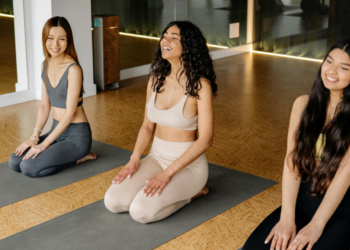“], “filter”: { “nextExceptions”: “img, blockquote, div”, “nextContainsExceptions”: “img, blockquote, a.btn, a.o-button”} }”>
Heading out the door? Learn this text on the brand new Outdoors+ app obtainable now on iOS gadgets for members!
>”,”identify”:”in-content-cta”,”kind”:”hyperlink”}}”>Obtain the app.
It’s not precisely a shock that loads of athletes battle when studying yoga.
In case you’re a runner, hiker, bicycle owner, triathlete, skier, climber, weightlifter, or some other kind of endurance athlete, the repeated motion patterns and depth of your coaching probably end in some critically tight muscle mass. And that pressure could make creating unfamiliar shapes along with your physique difficult.
That’s not the one workout-related sample that make adjusting to yoga a problem. Following are some widespread habits that athletes confront when working towards yoga however could not understand together with the best way to sidestep them. As a result of for those who take the time to work yoga into your coaching, you need to maximize its effectivity and reduce its annoyance. The next recommendation may help.
And in case you aren’t accustomed to the perks of yoga for athletes, they embrace the discharge of long-held muscular pressure, improved mobility, consideration to underdeveloped muscle mass, extra environment friendly respiratory, and enhanced physique consciousness so you’ll be able to deal with aches and strains earlier than they turn into accidents. (Satisfied but?)
5 Frequent Points Athletes Expertise in Yoga
The next are related whether or not you’re taking class on-line at house or in a crowded yoga studio.
1. Ignoring Muscle Tightness
“Any time a muscle is overly tight—be that stiff, brief, or tight—one of many largest considerations is potential damage, like tearing a muscle attributable to its lack of ability to increase and contract,” says Katya Campbell, an authorized motion and mobility specialist, yoga instructor, and CrossFit coach in British Columbia.
Even essentially the most delicate situation with tightness not solely compromises flexibility however can create a domino impact above and beneath the affected joints. That’s as a result of every thing is linked by way of fascia, muscle mass, ligaments, tendons, and joints. One thing occurring along with your left ankle will ultimately have an effect on your knees, hips, again, and doubtlessly your shoulders if left unadressed.
“Tightness may add undue pressure on different elements of our physique that have to compensate for this lack of motion,” says Campbell. She explains that cyclists and runners are inclined to expertise persistently tense hamstrings. This will result in points in poses that depend on the hamstrings to have a sure measure of flexibility. When these muscle mass are taxed past their skill to stretch, the decrease again compensates, which causes pressure and ache within the lumbar area.
For instance, for those who apply Standing Ahead Bend with tight hamstrings and pressure your self to attempt to attain your arms to the ground, you might overstretch the muscle mass within the decrease again and the small ligaments between the lumbar vertebrae. It is because the restricted vary of movement and extensibility within the hamstrings trigger the decrease again muscle mass to compensate, doubtlessly resulting in damage. Taking a modification (see beneath) or just permitting your self to not pressure the stretch may be the distinction between combating a stretch and permitting it to do its meant work.
2. Not Modifying a Yoga Pose
It’s not unusual for high-performing athletes to think about making an attempt a variation of a yoga pose as taking the simple method out and even “dishonest.” However these modifications exist to permit for a safer apply.
Whenever you try an unfamiliar form in yoga, it may be simple to fixate on the alignment you see a instructor apply. However the reality is, every pose appears completely different in every physique, particularly when you have tight muscle mass.
Permitting for a slight bend within the knee throughout a Standing Ahead Bend reasonably than conserving your legs straight or supporting your physique with pillows and bolsters are a number of the methods that you would be able to modify yoga poses to compensate for inflexibility or problem holding correctly. Utilizing yoga blocks and different props assist help your physique. They’ll carry the bottom as much as your arms to scale back pressure on tight muscle mass.
RELATED: 20 Yoga Hacks if You Have (Unbearably) Tight Hamstrings
3. Counting on Power-Coaching Habits
There are a handful of strength-training workouts which can be similar to yoga. For instance, the identical actual form and muscle engagement takes place in Bridge Pose and numerous forms of lunges no matter whether or not you’re working towards yoga or body weight coaching.
However some strength-training workouts could look similar in alignment however are distinctly completely different in muscular engagement. In case you are transitioning to yoga from power coaching or some other type of coaching and have turn into accustomed to particular methods, work with a yoga instructor or comply with a guided yoga exercise to study the posture and muscle engagement every poses in yoga calls for.
4. Holding Your Breath
The breath is often secondary to the bodily depth of a sport’s demand. Consider weightlifters who interact in high-intensity power coaching, reminiscent of barbell again squats, which includes holding the breath to brace the backbone and core.
Alternatively, yoga is as a lot about breathwork as it’s about motion. Some types of yoga join your movement to the rhythm of your inhalations and exhalations whereas others ask you to stay nonetheless when you slowly breathe. The important thing right here is respiratory steadily and deeply, out and in by way of the nostril, in a sluggish and regular rhythm.
5. Speeding
In case you already cram an hour or so of coaching into your already packed day, you won’t be included to take a couple of minutes to stretch as a part of your cool-down. And for those who do, chances are high you rush by way of them. However this shortchanges the advantages of yoga for athletes.
Not solely is it necessary to carry a pose for sufficient time to really strengthen or stretch the muscle mass, that sustained focus is a necessary side of turning into centered, lowering stress, and turning inward to join your thoughts and physique.
The excellent news is {that a} yoga routine doesn’t must be lengthy to be efficient. For instance, I often spend simply 10 to fifteen minutes working by way of my yoga for marathon runners routine.
However there is a crucial caveat: the objective is to be aware and current. Yoga is far more about high quality over amount.
Slowing down in and of itself is without doubt one of the important advantages of yoga for power and endurance athletes. I like to recommend holding yoga poses for 30 to 60 seconds every. This size of time will strengthen muscle mass in poses reminiscent of Boat, Plank, or any of the Warrior poses.
And whenever you’re stretching, that period of time permits your sensory receptors to relay messages to the spinal twine and mind to loosen up the muscle fibers, tendons, and connective tissues in an effort to maximally profit from the stretch reasonably than simply examine it off your listing.
Lingering a little bit longer within the stretch additionally ensures you could have sufficient time to settle into the pose, turn into conscious whether or not you’re participating or releasing the proper muscle mass, consider how your physique is responding to the pose, and noting which muscle mass are resistant and will use additional work your subsequent session.
Every of those takeaways from working towards yoga for athletes gives an avenue to scale back the probability of damage, improve your consciousness of smaller muscle mass, and enhance your mind-body connection. This allows you to interact the proper muscle mass when you run, bike, or carry out no matter kind of train has you coaching quite a few hours per week.
So whenever you take the time to apply yoga, make sure you’re really working towards yoga. The distinction is that you just’ll really expertise its impact in your coaching and your restoration.












